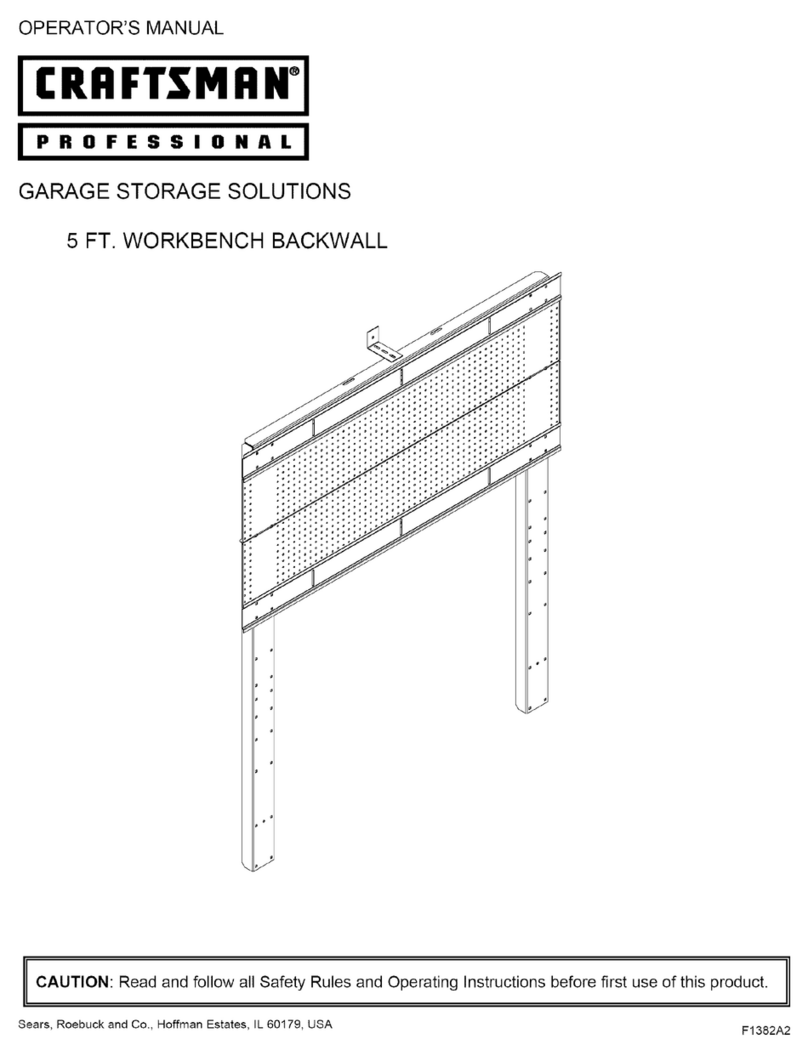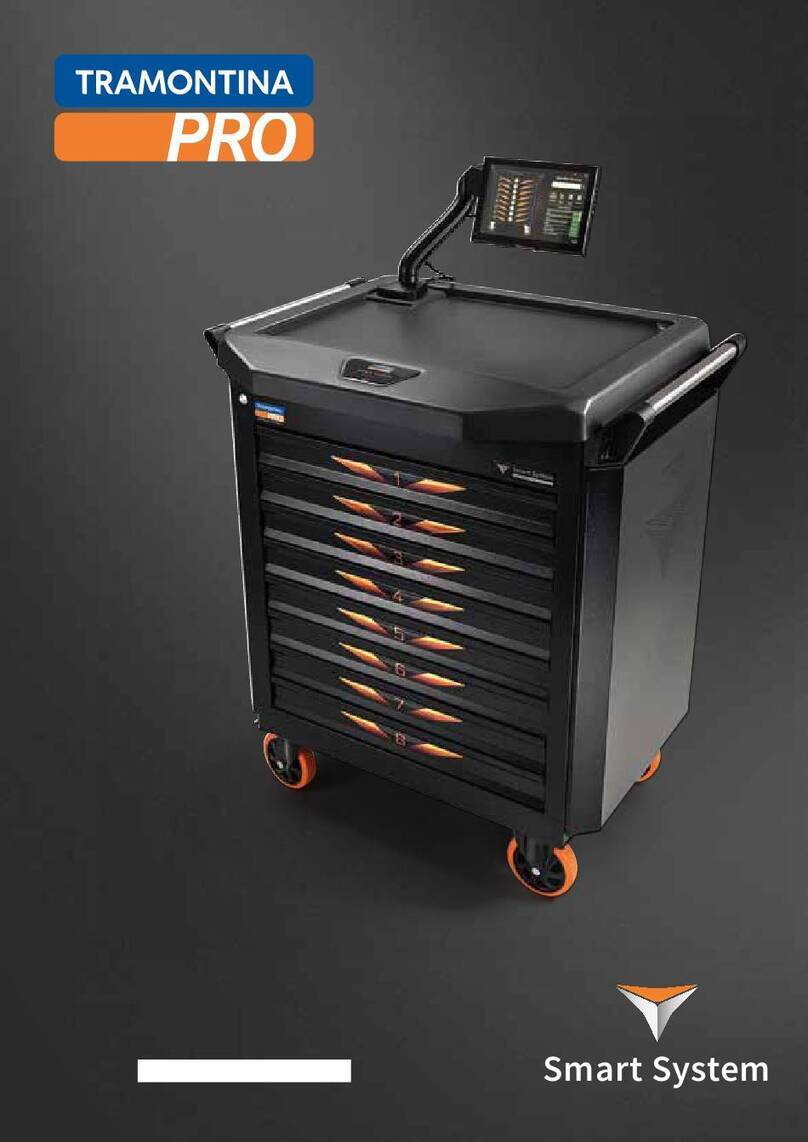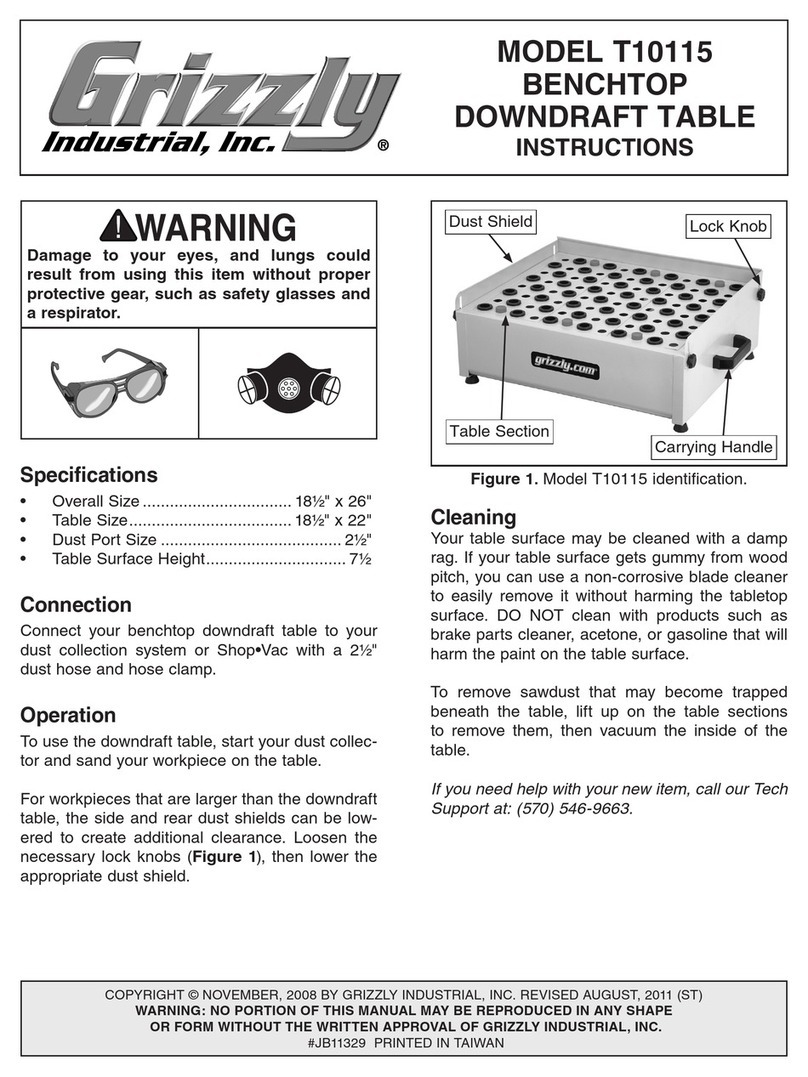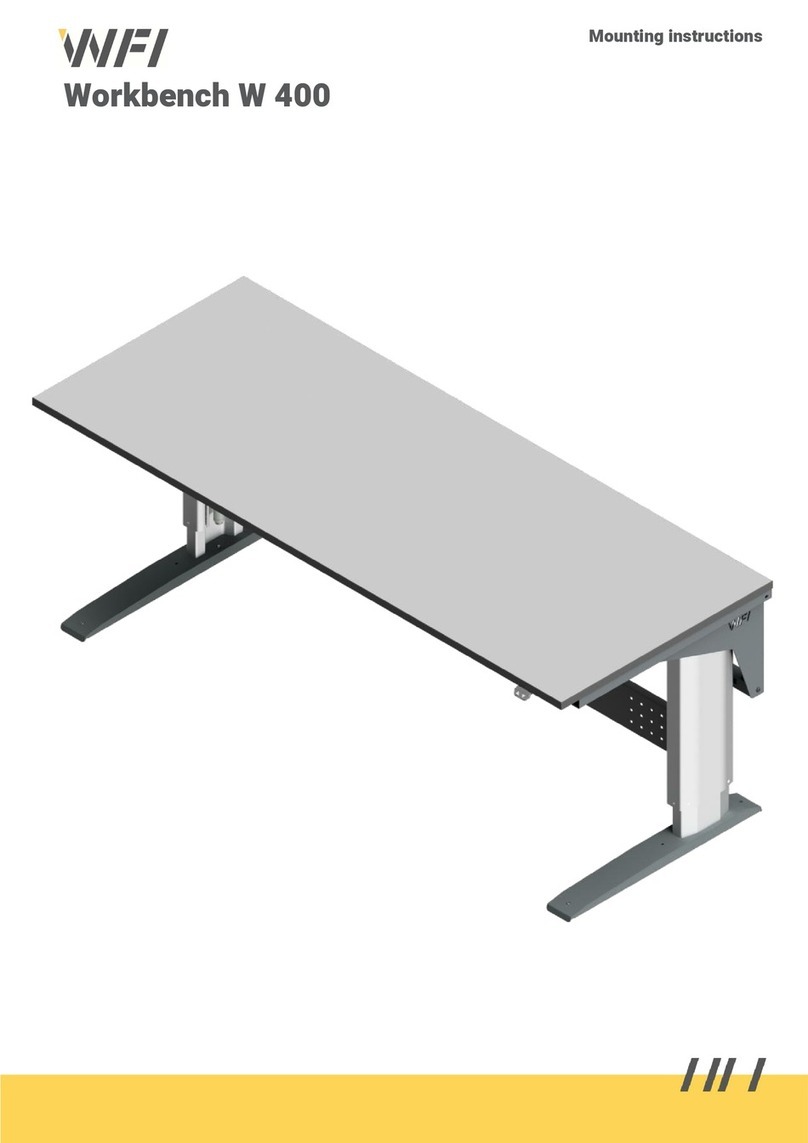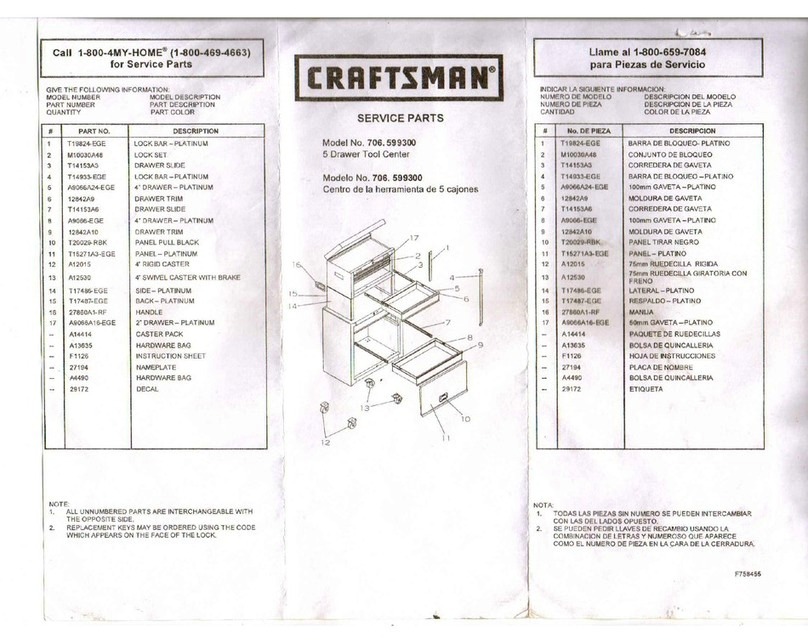Total Source 124TA2106 User manual

OPERATING MANUAL
SAFETY TRESTLE
124TA2106
Original operating
manual
05/2021 – V01

2/20
© 05-2021. TVH
®
and TotalSource
®
are registered trademarks. TVH Parts Holding NV, Brabantstraat 15, B-8790 Waregem. All rights reserved.
No part of this publication may be reproduced or communicated in any form or by any means, electronic or mechanical, including copying,
recording or use in an information storage or retrieval system, without prior and explicit permission of TVH Parts Holding NV. Printing errors
reserved. Photographs and illustrations are included for reference purposes only.
Responsible editor: TVH Parts Holding NV, Brabantstraat 15, BE-8790 Waregem
TVH is a supplier of after-market spare parts and accessories that are suitable for the maintenance and repair of OEM equipment.

3/20
www.tvh.com/safetytrestle_rv01
BG Bulgarian Можете да намерите това ръководство на Вашия език чрез линка, посочен по–
долу.
CS Czech Tento návod najdete ve svém jazyce prostřednictvím odkazu níže.
DA Danish Du kan finde denne vejledning på dit sprog via nedenstående link.
DE German Sie finden diese Bedienungsanleitung in Ihrer Sprache unter folgendem Link.
EL Greek Μπορείτε να βρείτε αυτό το εγχειρίδιο στη γλώσσα σας μέσω του παρακάτω
συνδέσμου.
EN English You can find this manual in your language via below link.
ES Spanish Encontrarás este manual en su propio idioma a través del siguiente enlace.
ET Estonian Oma emakeelse juhendi leiate allolevalt lingilt.
FI Finnish Löydät tämän manuaalin omalla kielelläsi alla olevan linkin takaa.
FR French Vous trouverez ce manuel dans votre langue via le lien ci-dessous.
GA Irish Tá an lámhleabhar seo ar fáil i do theanga tríd an nasc thíos.
HR Croatian Ovaj prirucnik mozete pronaci na svom jeziku putem donjeg linka.
HU Hungarian Ez a kézikönyv az Ön nyelvén az alábbi link alatt található.
IS Icelandic Hægt er að finna þessa handbók á þínu tungumáli á tenglinum hér að neðan.
IT Italian Cliccando sul link sottostante troverai il manuale nella tua lingua.
LT Lithuanian Šį vadovlėlį savo kalba rasite spustelėję žemiau esančią nuorodą.
LV Latvian Rokasgrāmatu latviešu valodā Jūs varat atrast izmantojot zemāk esošo saiti.
MT Maltese Tista’ ssib dan il-manwal bil-lingwa tiegħek permezz tal-link ta’ hawn taħt.
NL Dutch Je vindt deze handleiding in jouw taal via onderstaande link.
NO Norwegian Du finner denne håndboken på ditt språk via linken nedenfor.
PL Polish Niniejsza instrukcja obsługi dostępna jest w Twoim języku za pośrednictwem
poniższego linku.
PT Portuguese Pode encontrar este manual no seu idioma através do link abaixo.
RO Romanian Puteți găsi acest manual în limba dvs. prin link-ul de mai jos.
SK Slovak Manuál vo vašom jazyku môžete nájst v priloženom vysvietenom riadku.
SL Slovenian Ta priročnik najdete v svojem jeziku preko spodnje povezave.
SV Swedish Du kan hitta denna manual på ditt språk via länken nedan.
TR Turkish Bu kılavuzu aşağıdaki bağlantıdan kendi dilinizde bulabilirsiniz.

4/20
Thank you for using our product. For your safety and to ensure a correct operation, we would
like to bring to your attention some aspects of this manual:
• This booklet supplies useful instructions for the correct operation and maintenance of the
product. It is therefore necessary to pay the utmost attention to all of the paragraphs that
illustrate the most simple and secure way to operate and use this product.
• This booklet must be considered an integral part of the machine and must be included
with the deed of sale.
• Neither this publication, nor part of it, can be reproduced without written authorisation on
the part of the manufacturer.
• All of the information reported herein is based on data available at the moment of printing;
the manufacturer reserves the right to carry out modifications to its own products at any
moment, without notice and without incurring in any sanction. It is therefore suggested to
always check for possible updates.
The person responsible for the use of the product must make sure that all of the safety rules
in force in the country of its use are applied, to guarantee that the equipment is used in
conformity with the use for which it is destined and to avoid any dangerous situation for the
user.
The following warning signs are used in this manual to warn you for dangers and risks:
Informative, be careful.
Warning, can lead to injury and damage if instructions aren’t followed.
Danger, can lead to serious or fatal injury and serious damage if instructions
aren’t followed.
The following conventions are used in this manual:
1
4
2
3
1 Right
2 Left
3 Bottom
4Top

5/20
TABLE OF CONTENTS
1. INTRODUCTION..................................................................................... 6
2. DESCRIPTION....................................................................................... 8
2.1. Technical data .......................................................................................8
2.2. Main components of the product.................................................................8
2.3. Type plate. . . . . . . . . . . . . . . . . . . . . . . . . . . . . . . . . . . . . . . . . . . . . . . . . . . . . . . . . . . . . . . . . . . . . . . . . . . . . . . . . . . . . . . . . . . . . 9
3. SAFETY INSTRUCTIONS.........................................................................10
3.1. Explanation of the safety decals ................................................................10
3.2. General safety instructions ......................................................................10
4. TRANSPORT AND STORAGE ....................................................................11
5. ASSEMBLY AND INSTALLATION ...............................................................12
5.1. Packing list..........................................................................................12
5.2. Safety instructions.................................................................................12
5.3. Required material for assembly.................................................................12
5.4. Assembly of the product..........................................................................12
6. OPERATION.........................................................................................13
6.1. Safety instructions for operating the product ................................................13
6.2. Operating instructions ............................................................................13
7. MAINTENANCE ....................................................................................15
7.1. Safety instructions for the repair of the product .............................................15
7.2. Maintenance schedule............................................................................15
7.3. Maintenance instructions ........................................................................15
8. TROUBLESHOOTING .............................................................................17
9. FINAL DECOMMISSIONING AND DISPOSAL ................................................18

6/20
1. INTRODUCTION
This manual contains all the necessary information about the installation and operation of
the safety trestle.
Some of the maintenance operations should only be carried out by professional technicians.
If you need this information and the maintenance steps, please contact your dealer.
Also included in this manual are a number of safety instructions to create a safe working
environment.
These safety trestle is designed to support rated capacity, and is used to support a trailer
while loading or unloading a truck. Use both stands for each operation. Do not exceed the
maximum working load limit of these safety trestles. Do not use them for any other purpose
other than supporting a trailer. Never use the trestle to support any structure or building.
Donot support any human load.
Please read the manual thoroughly and observe the safety procedures before putting the
unit into operation. The operator and all persons who come into contact with the equipment
should read it carefully and regularly and have access to it at all times.
Keep this manual near the equipment and in a safe place for future reference!
Contact your dealer for any further questions or concerns you may have.
We guarantee a long period of trouble free operation if the unit is operated and maintained
correctly.
We hope you will enjoy working with your safety trestle.
If you wish to use this safety trestle in extreme conditions such as extreme heat,
extreme cold, extreme drought, etc. Please contact your dealer to discuss whether
this product is suitable for the activities you wish to undertake with the trestle.
Consult the manual of the truck and/or trailer to know where to place the safety trestle.

7/20
This safety trestle may be unsafe if adequate maintenance is neglected. Therefore,
adequate maintenance facilities, trained personnel and procedures should be
provided.
Maintenance and inspection shall be performed in conformity with the following
practices:
1. A scheduled planned maintenance, lubrication and inspection system should be
followed (see maintenance instructions chapter8).
2. Only qualified and authorised personnel shall be permitted to maintain, repair,
adjust and inspect the fork positioner.
3. Modifications and additions which affect capacity and safe operation shall not
be performed by the customer or user without the manufacturer’s prior written
approval. Capacity, operation and maintenance plates or decals shall be changed
accordingly.
4. If modifications are made without written approval of the manufacturer, warranty
will no longer apply.
Any person in charge of putting the machine into operation, the operation itself or
the maintenance of the machine is urged to carefully read and observe the following
instructions.
Make sure that the operators of this product are familiar with the safety instructions
and follow all the procedures. Neglecting these instructions can risk injury or death.

8/20
2. DESCRIPTION
2.1. Technical data
Always check the type plate for the correct information.
Type Safety trestle
Load (kg) 15000
Minimum height (mm) 1080
Maximum height (mm) (H1) 1300
Total length (mm) (L1) 1200
Total width (mm) (W1) 550
Weight (kg) 72
2.2. Main components of the product
1
2
4 3
N° Component
1Wooden support beam
2Height adjustment hole/pin
3Transport lever
4 Wheels
L1
H1/H2
W1

9/20
2.3. Type plate
Serienummer - Numéro de serie -
Manufactured outside the EU for:
TVH PARTS NV
Brabantstraat 15 • 8790 Waregem • Belgium
Bouwjaar - Année de
construction - Year of
construction - Bauhjahr
Gewicht - Poids - Weight
Capacity - Capacité - Capacity
Type - Typ
Model - Modèle - Model - Modell
XXX
XXX
50 KG
15000 KG
124TA2106
Safety trestle
3
2
1
4
5
6
7
N° Explanation
1Name and address of the manufacturer
2 Model
3Type of product
4Construction year
5Serial number
6Weight of the product (kg)
7Capacity of the product (kg)

10/20
3. SAFETY INSTRUCTIONS
3.1. Explanation of the safety decals
If the decals are damaged or missing, please replace them.
Explanation Reference
Read the manual before use 163TA4380
3.2. General safety instructions
Inspect before every use. Examine the safety trestle for cracks or damage before
each use. Do not use if even a minor crack, bend or other damage/deformation is
found. Discard the safety trestle if damaged or deformed.
The person responsible for the use of the product must make sure that all of the
safety rules in force in the country of its use are applied, to guarantee that the
equipment is used in conformity with the use for which it is destined and to avoid any
dangerous situation for the user.
Do not operate the product unless you are of age.
Consult the manual of the truck and/or trailer to know where to place the trailer
safety jack.
Do not place the trailer safety jack directly against the trailer but keep a margin of
±10cm (±4inches).
• TVH Parts Holding NV can’t anticipate all possible circumstances that might result
in danger. Therefore, the warnings given in this publication, and those that appear
on the equipment, are not exhaustive.
In the event that equipment, procedures, work methods or working techniques
are used that are not specifically advised by the TVH Parts Holding NV company, it
must be ensured that there is no danger to the operator or other people.
• Study, understand and follow all instructions before operating this equipment.
• Do not exceed the rated capacity, be aware of dynamic loading.
• Use only on hard, level surfaces.
• Ensure that the safety trestle is in correct position in relation to the trailer.
• In the event of unsafe use, limbs or persons can get stuck between the trailer and
the safety trestle.
• Others who are not working on the vehicle must keep a minimum distance of 0.5m
from the vehicle.
• It is not recommended to support the following with this equipment: foundations,
homes, mobile homes, RVs, campers, aircrafts, fifth wheels.
• No alterations shall be made to this product. The pins are installed in such a way
that the safety standards are respected and may never be replaced by anything
else.
• Do not move the vehicle while on a safety trestle.

11/20
4. TRANSPORT AND STORAGE
Transport the safety trestle to the work area by either wheeling it or lifting and carryingit.
The safety trestle should always be wheeled to the work area if possible– only lift and
carry the safety trestle if it cannot be wheeled safely. Wheel the safety trestle only across
smooth surfaces. If the surface is rough or uneven, lift and carry the safety trestle instead of
wheeling it.
Jolting caused by the wheels catching on uneven surfaces can cause physical strain
and personal injury.
1. How to wheel the safety trestle
1. Make sure the safety trestle is rolled on flat and smooth surfaces. If the surface is rough
or uneven, lift and carry the safety trestle instead of rolling it.
2. Pull the lever up to raise the forefoot from the ground. Now the safety trestle can roll
freely on its wheels.
2. How to lift and carry the safety trestle
1. Determine the lifting points on the safety trestle. Hold the grey frame to carry the safety
trestle.
Never lift the safety trestle by the transport lever or by the red lifting frame
2. Lift and carry the safety trestle. When possible, have someone help you lift and carry the
safety trestle.
DO NOT attempt to lift the safety trestle if you suffer any physical condition that
prevents you from lifting the safety trestle safely.
Store the safety trestle level, in a clean environment, preferably indoors and in a dry area to
protect the trestle from moisture.
Also protect your safety trestle from direct sunlight. Make sure that the room temperature
remains constant.
If the equipment is stored outdoors, be sure to lubricate all parts before and after use to
ensure the equipment stays in good working condition.
If you store the equipment in another environment please note that the internal workings of
the stands can be affected by high moisture, gravel or sand, salt, grit or other dust-laden air.
The trestle should have its inner components frequently cleaned, inspected and lubricated.

12/20
5. ASSEMBLY AND INSTALLATION
5.1. Packing list
Description Amount Reference
Safety trestle 1 124TA2106
Operating manual 1 166TA7668
5.2. Safety instructions
Wear safety gloves and safety shoes when assembling the safety trestle.
5.3. Required material for assembly
To assemble this safety trestle you need the standard size of a wrench.
5.4. Assembly of the product
1. Place the base of the safety trestle on a firm and steady surface.
2. Take the handle and place it at the right side of the trestle, atthe opposite side of the
wheels.
3. Take the first bolt and place it in the lower hole. Tighten it manually with the nut.
4. Take the second bolt and place it in the top hole. Tighten it manually with the nut.
5. After the bolts and nuts have been tightened manually, take the wrench and tighten them
further to the point that they are tightened properly and the lever is no longer loose in its
support points.

13/20
6. OPERATION
6.1. Safety instructions for operating the product
• Keep the work area well illuminated.
• Make sure that the support legs are completely down and make a firm contact with
the ground.
• When the safety trestle is in use make sure that no persons are in the vicinity of the
safety trestle or walk underneath the trailer to prevent serious injuries.
• Do not place the safety trestle directly against the trailer but keep a margin of
±10cm (±4inches).
• Consult the manual of the truck and/or trailer to know where to place the safety
trestle.
• A damaged or malfunctioning product must never be used. If damage or
malfunctions are discovered during pre-operation inspection or function tests,
theproduct must be tagged and removed from service.
• Use the safety trestle only on hard level surfaces. Uneven or sloped surfaces create
dangerous working conditions and dangerously obstruct the function of the safety
trestle.
• Disconnect the pressure line between the truck and the trailer so that the brakes
are on the rear wheels.
• Only when the person who has safely placed the safety trestle gives the sign that
the installation has been completed, the driver can safely remove the truck.
• Others who are not working on the vehicle must keep a minimum distance of 0.5 m
from the vehicle.
6.2. Operating instructions
Carry out the daily maintenance check listed in chapter7.
1. Correct positioning of the safety trestle:
1. Place the safety trestle behind the back wheels of the cabin.
2. Push the handle down to lift the wheels from the ground.
Thesafety trestle is now steady and firm on the ground.
3. Lift the wooden beam support as close to the trailer as
possible, but leave a margin of ±10cm (±4inches).

14/20
4. Place the safety pins in the height adjustment holes.
5. Now the trailer is secured and the truck can drive away.
2. Correctly remove the safety trestle:
The safety trestle may only be removed if the work has been completed. Make sure
that there are no persons or vehicles in the trailer when you remove the safety
trestle.
1. Push the handle upwards so that the wheels touch the ground
again.
2. Remove the safety trestle from underneath the trailer.
3. Remove the safety pins from the height adjustment holes.
Failure to follow the above instructions may result in serious and/or fatal injuries
and/or serious damage to the material.

15/20
7. MAINTENANCE
7.1. Safety instructions for the repair of the product
Some of the maintenance operations should only be carried out by professional
technicians.
If you need this information and the maintenance steps, please contact your dealer
• Do not attempt to repair the product unless you are trained and authorised to
doso.
• Repairs to the product may only be carried out by a qualified service technician and
according to the manufacturer’s instructions.
• Always wear safety gloves and shoes
• Others who are not working on the vehicle must keep a minimum distance of 0.5m
from the vehicle.
7.2. Maintenance schedule
Task D W M
1. Inspect for damage or cracks
2. Cleaning
3. Lubrication
D: daily, W: weekly, M: monthly
7.3. Maintenance instructions
1. Inspect for damage or cracks
A daily check of the safety trestles can limit wear to a minimum:
• Ensure that the instruction manual is complete, legible and available for reference;
• Ensure that all decals are legible and in place;
• Check entire machine for: damage, corrosion or cracks in structural components.
This maintenance may be carried out by the operator.
2. Cleaning
• Clean as needed and wipe with an oily cloth.
• When you use a high-pressure cleaner, do not direct the jet onto the bearings and seals,
otherwise the grease will be washed out and the lifespan of the trestle will be shortened.
• Never use sandpaper or abrasive material on these surfaces!
This maintenance may be carried out by the operator.

16/20
3. Lubrication
A periodic coating of lubricating oil at pivot points will help to prevent rust and assure that
the wooden support beam assemblies move freely.
This maintenance may be carried out by the operator.
Where to lubricate
Please see pictures below for the pivot points that need a periodic coating of lubrication.
Use a non-abrasive grease to lubricate the mechanical parts. For example REF107TA8448 is
the best choice because it is water-repellent and resistant to weather influences.

17/20
8. TROUBLESHOOTING
N° Problem Cause Action
1The wheels do not
fold in or out
There is dust or dirt in the pivot points Clean the pivot points with a cloth
and lubricate
The connection point between the
lever and the wheels has come loose
Tighten every bolt and nut from the
lever point to the handle
2The wheels don’t
roll
There is dust or dirt in the pivot points Clean the pivot points with a cloth
and lubricate
The lever is not fully raised Raise the lever
3The height
adjustment pin
won’t fit the height
adjustment holes
The two horizontal holes are not in
line with each other
Move the wooden support beam a
little bit so the pin can slide in
4Wooden support
beam does not go
up or down
There is dust and/or dirt at the sliding
points
Clean the safety trestle with a cloth
and lubricate the pivot points
The locking pin is still in a height
adjustment hole
Take out the locking pin and move the
wooden support beam to the desired
height
5Wooden support
beam is skewed
The two locking pins are at a different
height
Check what pin is in the wrong height
adjustment hole and adjust the
wooden support beam to the desired
height
6Handle hangs
loose
The bolts and nuts are coming loose Tighten the bolts and nuts with a
wrench
7Cracking, bending
or breaking
Stop using the stands and replace
them by new ones
If none of these troubleshooting suggestions or solutions were helpful, please contact your
local dealer or the manufacturer.

18/20
9. FINAL DECOMMISSIONING AND DISPOSAL
Final, proper decommissioning or disposal of the product must be performed in accordance
with the regulations of the country in which the product is used. In particular, regulations
governing the disposal of batteries, fuels and electronic and electrical systems must be
observed.
Waste packaging should be sorted and put into solid dustbins according to the materials and
needs to be collected by the local special environment protection bureau.
To avoid pollution, it’s forbidden to throw away the waste randomly. To avoid pollution during
the use of the product, the user should prepare some absorbing materials (scraps of wood
or dry duster cloth) to absorb leaking fluids in time. To avoid secondary pollution to the
environment, the used absorbing materials should be handed in at special departments of
local authorities.

19/20
. . . . . . . . . . . . . . . . . . . . . . . . . . . . . . . . . . . . . . . . . . . . . . . . . . . . . . . . . . . . . . . . . . . . . . . . . . . . . . . . . . . . . . . . . . . . . . . . . . . . . . . . . . . . . . . . . . . . .
. . . . . . . . . . . . . . . . . . . . . . . . . . . . . . . . . . . . . . . . . . . . . . . . . . . . . . . . . . . . . . . . . . . . . . . . . . . . . . . . . . . . . . . . . . . . . . . . . . . . . . . . . . . . . . . . . . . . .
. . . . . . . . . . . . . . . . . . . . . . . . . . . . . . . . . . . . . . . . . . . . . . . . . . . . . . . . . . . . . . . . . . . . . . . . . . . . . . . . . . . . . . . . . . . . . . . . . . . . . . . . . . . . . . . . . . . . .
. . . . . . . . . . . . . . . . . . . . . . . . . . . . . . . . . . . . . . . . . . . . . . . . . . . . . . . . . . . . . . . . . . . . . . . . . . . . . . . . . . . . . . . . . . . . . . . . . . . . . . . . . . . . . . . . . . . . .
. . . . . . . . . . . . . . . . . . . . . . . . . . . . . . . . . . . . . . . . . . . . . . . . . . . . . . . . . . . . . . . . . . . . . . . . . . . . . . . . . . . . . . . . . . . . . . . . . . . . . . . . . . . . . . . . . . . . .
. . . . . . . . . . . . . . . . . . . . . . . . . . . . . . . . . . . . . . . . . . . . . . . . . . . . . . . . . . . . . . . . . . . . . . . . . . . . . . . . . . . . . . . . . . . . . . . . . . . . . . . . . . . . . . . . . . . . .
. . . . . . . . . . . . . . . . . . . . . . . . . . . . . . . . . . . . . . . . . . . . . . . . . . . . . . . . . . . . . . . . . . . . . . . . . . . . . . . . . . . . . . . . . . . . . . . . . . . . . . . . . . . . . . . . . . . . .
. . . . . . . . . . . . . . . . . . . . . . . . . . . . . . . . . . . . . . . . . . . . . . . . . . . . . . . . . . . . . . . . . . . . . . . . . . . . . . . . . . . . . . . . . . . . . . . . . . . . . . . . . . . . . . . . . . . . .
. . . . . . . . . . . . . . . . . . . . . . . . . . . . . . . . . . . . . . . . . . . . . . . . . . . . . . . . . . . . . . . . . . . . . . . . . . . . . . . . . . . . . . . . . . . . . . . . . . . . . . . . . . . . . . . . . . . . .
. . . . . . . . . . . . . . . . . . . . . . . . . . . . . . . . . . . . . . . . . . . . . . . . . . . . . . . . . . . . . . . . . . . . . . . . . . . . . . . . . . . . . . . . . . . . . . . . . . . . . . . . . . . . . . . . . . . . .
. . . . . . . . . . . . . . . . . . . . . . . . . . . . . . . . . . . . . . . . . . . . . . . . . . . . . . . . . . . . . . . . . . . . . . . . . . . . . . . . . . . . . . . . . . . . . . . . . . . . . . . . . . . . . . . . . . . . .
. . . . . . . . . . . . . . . . . . . . . . . . . . . . . . . . . . . . . . . . . . . . . . . . . . . . . . . . . . . . . . . . . . . . . . . . . . . . . . . . . . . . . . . . . . . . . . . . . . . . . . . . . . . . . . . . . . . . .
. . . . . . . . . . . . . . . . . . . . . . . . . . . . . . . . . . . . . . . . . . . . . . . . . . . . . . . . . . . . . . . . . . . . . . . . . . . . . . . . . . . . . . . . . . . . . . . . . . . . . . . . . . . . . . . . . . . . .
. . . . . . . . . . . . . . . . . . . . . . . . . . . . . . . . . . . . . . . . . . . . . . . . . . . . . . . . . . . . . . . . . . . . . . . . . . . . . . . . . . . . . . . . . . . . . . . . . . . . . . . . . . . . . . . . . . . . .
. . . . . . . . . . . . . . . . . . . . . . . . . . . . . . . . . . . . . . . . . . . . . . . . . . . . . . . . . . . . . . . . . . . . . . . . . . . . . . . . . . . . . . . . . . . . . . . . . . . . . . . . . . . . . . . . . . . . .
. . . . . . . . . . . . . . . . . . . . . . . . . . . . . . . . . . . . . . . . . . . . . . . . . . . . . . . . . . . . . . . . . . . . . . . . . . . . . . . . . . . . . . . . . . . . . . . . . . . . . . . . . . . . . . . . . . . . .
. . . . . . . . . . . . . . . . . . . . . . . . . . . . . . . . . . . . . . . . . . . . . . . . . . . . . . . . . . . . . . . . . . . . . . . . . . . . . . . . . . . . . . . . . . . . . . . . . . . . . . . . . . . . . . . . . . . . .
. . . . . . . . . . . . . . . . . . . . . . . . . . . . . . . . . . . . . . . . . . . . . . . . . . . . . . . . . . . . . . . . . . . . . . . . . . . . . . . . . . . . . . . . . . . . . . . . . . . . . . . . . . . . . . . . . . . . .
. . . . . . . . . . . . . . . . . . . . . . . . . . . . . . . . . . . . . . . . . . . . . . . . . . . . . . . . . . . . . . . . . . . . . . . . . . . . . . . . . . . . . . . . . . . . . . . . . . . . . . . . . . . . . . . . . . . . .
. . . . . . . . . . . . . . . . . . . . . . . . . . . . . . . . . . . . . . . . . . . . . . . . . . . . . . . . . . . . . . . . . . . . . . . . . . . . . . . . . . . . . . . . . . . . . . . . . . . . . . . . . . . . . . . . . . . . .
. . . . . . . . . . . . . . . . . . . . . . . . . . . . . . . . . . . . . . . . . . . . . . . . . . . . . . . . . . . . . . . . . . . . . . . . . . . . . . . . . . . . . . . . . . . . . . . . . . . . . . . . . . . . . . . . . . . . .
. . . . . . . . . . . . . . . . . . . . . . . . . . . . . . . . . . . . . . . . . . . . . . . . . . . . . . . . . . . . . . . . . . . . . . . . . . . . . . . . . . . . . . . . . . . . . . . . . . . . . . . . . . . . . . . . . . . . .
. . . . . . . . . . . . . . . . . . . . . . . . . . . . . . . . . . . . . . . . . . . . . . . . . . . . . . . . . . . . . . . . . . . . . . . . . . . . . . . . . . . . . . . . . . . . . . . . . . . . . . . . . . . . . . . . . . . . .
. . . . . . . . . . . . . . . . . . . . . . . . . . . . . . . . . . . . . . . . . . . . . . . . . . . . . . . . . . . . . . . . . . . . . . . . . . . . . . . . . . . . . . . . . . . . . . . . . . . . . . . . . . . . . . . . . . . . .
. . . . . . . . . . . . . . . . . . . . . . . . . . . . . . . . . . . . . . . . . . . . . . . . . . . . . . . . . . . . . . . . . . . . . . . . . . . . . . . . . . . . . . . . . . . . . . . . . . . . . . . . . . . . . . . . . . . . .
. . . . . . . . . . . . . . . . . . . . . . . . . . . . . . . . . . . . . . . . . . . . . . . . . . . . . . . . . . . . . . . . . . . . . . . . . . . . . . . . . . . . . . . . . . . . . . . . . . . . . . . . . . . . . . . . . . . . .
. . . . . . . . . . . . . . . . . . . . . . . . . . . . . . . . . . . . . . . . . . . . . . . . . . . . . . . . . . . . . . . . . . . . . . . . . . . . . . . . . . . . . . . . . . . . . . . . . . . . . . . . . . . . . . . . . . . . .
. . . . . . . . . . . . . . . . . . . . . . . . . . . . . . . . . . . . . . . . . . . . . . . . . . . . . . . . . . . . . . . . . . . . . . . . . . . . . . . . . . . . . . . . . . . . . . . . . . . . . . . . . . . . . . . . . . . . .
. . . . . . . . . . . . . . . . . . . . . . . . . . . . . . . . . . . . . . . . . . . . . . . . . . . . . . . . . . . . . . . . . . . . . . . . . . . . . . . . . . . . . . . . . . . . . . . . . . . . . . . . . . . . . . . . . . . . .
. . . . . . . . . . . . . . . . . . . . . . . . . . . . . . . . . . . . . . . . . . . . . . . . . . . . . . . . . . . . . . . . . . . . . . . . . . . . . . . . . . . . . . . . . . . . . . . . . . . . . . . . . . . . . . . . . . . . .
. . . . . . . . . . . . . . . . . . . . . . . . . . . . . . . . . . . . . . . . . . . . . . . . . . . . . . . . . . . . . . . . . . . . . . . . . . . . . . . . . . . . . . . . . . . . . . . . . . . . . . . . . . . . . . . . . . . . .
NOTES

TVH PARTS HOLDING NV
Brabantstraat 15 • 8790 Waregem • Belgium
REF 19295273 • 05-2021 • SL
Your distributor:
Manufactured outside the EU for:
Table of contents
Popular Tools Storage manuals by other brands

Grobet USA
Grobet USA New Jewelry Work Bench 13.071 Assembly instructions

HOLZMANN MASCHINEN
HOLZMANN MASCHINEN WB106MINI Assembly instruction
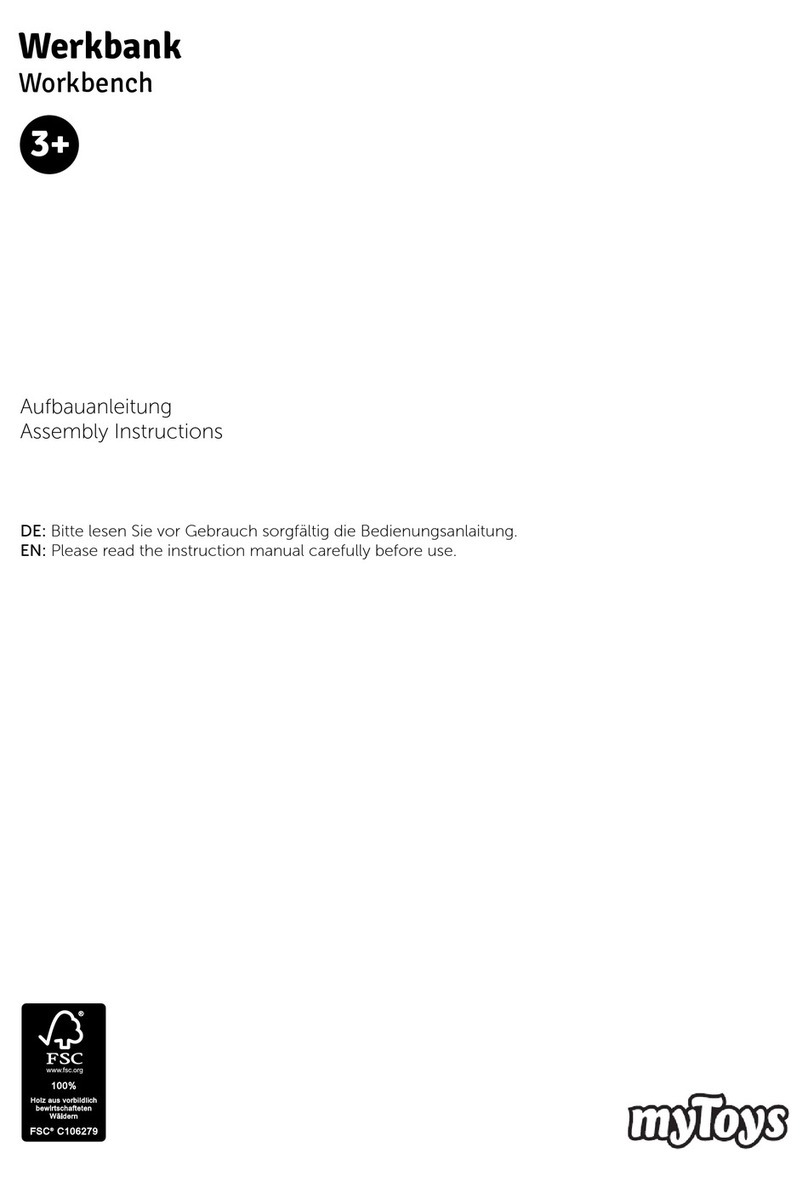
myToys
myToys Werkbank Assembly instructions
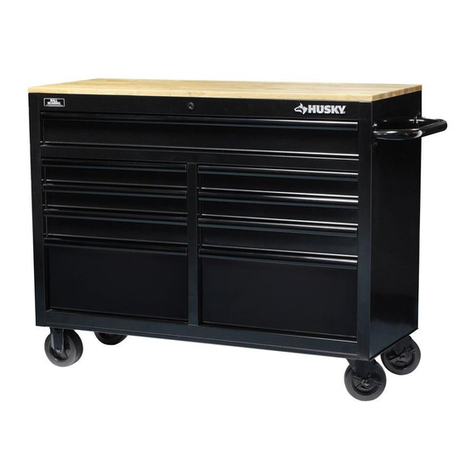
Husky
Husky 7440946b Use and care guide
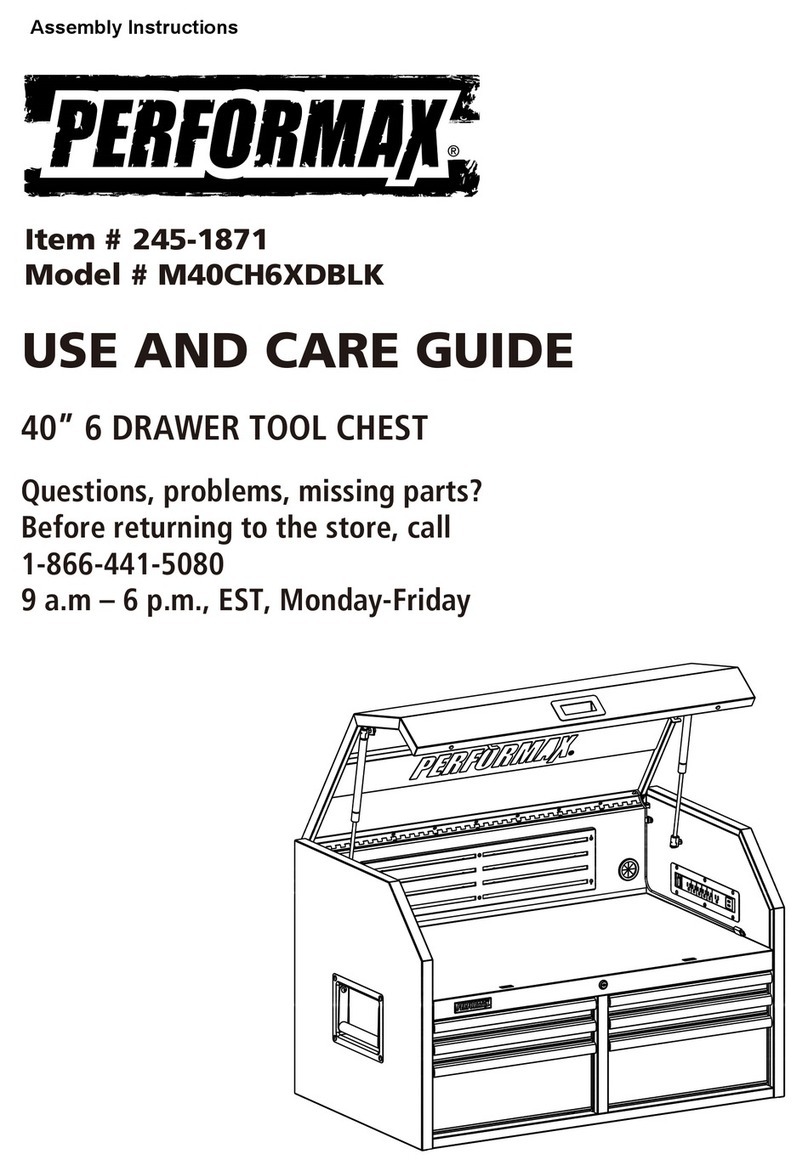
Performax
Performax M40CH6XDBLK Use and care guide

Speaka Professional
Speaka Professional SP-SSW-500 Important information





